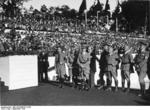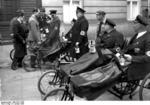Rudolf HeĂź
| Surname | HeĂź |
| Given Name | Rudolf |
| Born | 26 Apr 1894 |
| Died | 17 Aug 1987 |
| Country | Germany |
| Category | Government |
| Gender | Male |
Contributor: C. Peter Chen
ww2dbaseWalter Richard Rudolf HeĂź (sometimes written with the anglicized spelling Hess) was born in Alexandria, Egypt to a Bavarian merchant. His family moved back to Germany when he was 14 years old. After some time in Switzerland as a student, he enlisted in the 7th Bavarian Field Artillery Regiment as an infantryman when WW1 broke out. During the war, he became a pilot. During the inter-war years, he was active in a para-military Freikorps organization while he studied social sciences in the University of Munich. He also became associated with the Nazi Party from its early days, taking part in the Beer Hall Putsch and edited Adolf Hitler's Mein Kampf. Certain historians noted HeĂź's homosexual tendencies, and hypothesized that he might have been one of Hitler's sexual partners. He was eventually married, perhaps only at Hitler's insistence, but remained childless until 1937.
ww2dbaseEventually, Heß rose to the status of being third in power among the Berlin elite behind Hitler and Hermann Göring. The spotlight, however, moved from him to the military leaders at the outbreak of WW2. On 10 May 1941, Heß flew a Messerschmitt Bf 110 to Britain to meet with Duke of Hamilton and Brandon to broker a peace between Britain and Germany. He was arrested after parachuted out of his aircraft, and his proposals for peace, especially with the fact that he did not officially represent Germany, were ignored. In Berlin, Hitler arrested his staff and announced that Heß had gone insane and did not represent Germany in any manner; Hitler replaced the position vacated by Heß with Martin Bormann.
ww2dbaseAfter the war, at the Nuremberg Trials, the International Military Tribunal found HeĂź guilty on two counts and sentenced him to life imprisonment. At Spandau Prison in Berlin, his mental condition deteriorated. In 1974, warden Eugene Bird published the book the Loneliest Man in the World about his relationship with Prisoner Number Seven. He committed suicide by strangling himself in Spandau Prison in 1987.
ww2dbaseSource: Wikipedia.
Last Major Revision: Apr 2006
Rudolf HeĂź Interactive Map
Photographs
 |  |  |  |
Rudolf HeĂź Timeline
| 26 Apr 1894 | Rudolf HeĂź was born in Alexandria, Egypt. |
| 10 May 1941 | Sparking a controversy that will last long after the war, Deputy FĂĽhrer Rudolf Hess landed in Scotland, United Kingdom with a Bf 110 fighter in an attempt to dissuade Duke of Hamilton to introduce him to King George VI in order to broker peace between the United Kingdom and Germany. This mission was not authorized by Adolf Hitler. He landed 12 miles from the Duke's residence, broke his ankle, and was arrested by a farmer. He was taken into custody and remained so until his death. |
| 15 May 1941 | British Minister of Labour Ernest Bevin declared that he would not negotiate with Rudolf HeĂź. |
| 20 May 1941 | Prime Minister Churchill noted that he was not prepared to make a statement on the arrival of Rudolf HeĂź in Britain. |
| 10 Jun 1941 | Lord Simon met with Rudolf HeĂź for 2.5 hours, during which Hess asked Lord Simon to work with the British government to negotiate peace with Germany. |
| 27 Aug 1943 | British Minister of Information Brenden Bracken announced that Rudolf HeĂź, "a Nazi of very low mentality", arrived in Britain in May 1941 to "find British Quislings to overthrow Churchill". |
| 16 Mar 1945 | Rudolf HeĂź noted that 2 million Jews were gassed between Jun 1941 and late 1943. |
| 8 Oct 1945 | Rudolph HeĂź was transported from Britain to NĂĽrnberg, Germany for trial. |
| 30 Nov 1945 | At the Nuremberg Trials, Rudolph HeĂź announced that he had been faking insanity and amnesia all along. |
| 17 Aug 1987 | Rudolf HeĂź passed away. |
Did you enjoy this article or find this article helpful? If so, please consider supporting us on Patreon. Even $1 per month will go a long way! Thank you. Share this article with your friends: Stay updated with WW2DB: |
Visitor Submitted Comments
22 Oct 2018 10:52:00 AM
According to test pilot Helmut Kaden, Hess had made three previous attempts to reach Britain. The first was on
21 December 1940, when he took off in clear weather only to return after three hours after dropping his signal pistol which lodged under his seat jamming the rudder controls. It was freed by the jolt when the Messerschmitt landed. He tried again in fine weather on 18 January 1941, but returned after three and a half hours complaining that there was a problem with the Auflugnavigation approach system (a kind of radio compass). The third attempt was on 30 April when he sat in the cockpit for some time with the engines running. Helmut Kaden believed that on this occasion he must have been instructed over the radio telephone not to take off.
All visitor submitted comments are opinions of those making the submissions and do not reflect views of WW2DB.
» Nuremberg Trials and Other Trials Against Germany
- » 1,150 biographies
- » 337 events
- » 43,917 timeline entries
- » 1,241 ships
- » 350 aircraft models
- » 207 vehicle models
- » 374 weapon models
- » 123 historical documents
- » 260 facilities
- » 470 book reviews
- » 28,540 photos
- » 432 maps
Chiang Kaishek, 31 Jul 1937
Please consider supporting us on Patreon. Even $1 a month will go a long way. Thank you!
Or, please support us by purchasing some WW2DB merchandise at TeeSpring, Thank you!
19 Feb 2009 02:08:00 PM
Rudolf Hess flew a Messerschmitt Bf. 110D to Scotland, in May 1941. Hess bailed out, and the aircraft crashed. The aircraft was coded (VJ+OQ) When questioned by the English, he gave his name as Cpt. Horn, until his true identity was known.